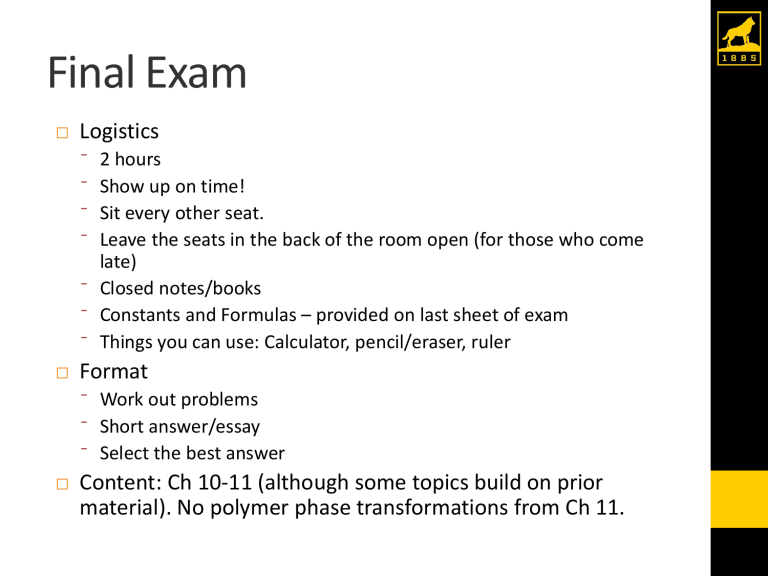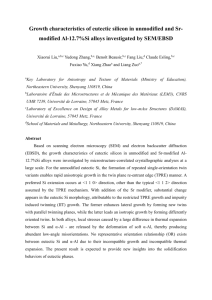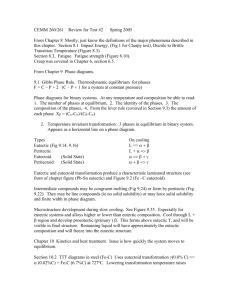
Final Exam □ Logistics ⁻ ⁻ ⁻ ⁻ 2 hours Show up on time! Sit every other seat. Leave the seats in the back of the room open (for those who come late) ⁻ Closed notes/books ⁻ Constants and Formulas – provided on last sheet of exam ⁻ Things you can use: Calculator, pencil/eraser, ruler □ Format ⁻ Work out problems ⁻ Short answer/essay ⁻ Select the best answer □ Content: Ch 10-11 (although some topics build on prior material). No polymer phase transformations from Ch 11. Topic List: Ch 10 □ Definitions: ⁻ Phase, component, solvent, solute, phase diagram, phase boundary, solubility, solubility limit, solid solubility, binary, isomorphous, liquidus line, solidus line, solvus line, eutectic, hypoeutectic, hypereutectic, ferrite, austinite, cementite, pearlite □ On a phase diagram, know how to identify: ⁻ ⁻ ⁻ ⁻ Compositions Temperatures Phases Microconstituents ⁻ Temperatures (melting points, first melting, first solidifying, etc) Chemical Compositions (first solid to form, first liquid to form, etc) Use of a tie line (and why) Use of lever rule (and why) Fraction of phases at various temperatures Fraction of microconstituents at various temperatures Composition of phases and microconstituents at various temperatures (for a single phase field or a two phase field) Composition of an alloy (given other information, such as temperature and fraction of a phase or microconstituent) □ On a phase diagram, know how to calculate ⁻ ⁻ ⁻ ⁻ ⁻ ⁻ ⁻ □ Why are alloys useful? □ Phase Diagrams ⁻ ⁻ ⁻ ⁻ Binary Isomorphous Eutectic Other invariant reactions (eutectoid, peritectic, peritectoid) Intermetallic compounds ⁻ ⁻ ⁻ Equilibrium Non-equilibrium Hyper- and Hypo- eutectoid (or eutectic) alloys ⁻ Solid solubility □ Development of microstructures on cooling ⁻ Primary phases form in addition to the eutectic □ Development of eutectic growth front (cooperative growth of alpha and beta plates) Topic List Ch 11 □ Definitions/Concepts ⁻ Phase transformations ⁻ Spheroidite – what it is (phases, morphology), how it is formed (time/temp), driving force for coarsening ⁻ Nucleation & Growth – dependence on temperature • Development of coarse and fine microstructures ⁻ Isothermal Transformation Curves • Pearlite (coarse, fine), Bainite (coarse, fine), Martensite • Mechanical properties of these (strength & ductility) • Tempered martensite & processing (tempering curves) □ Why alloy steel? ⁻ Effect on IT curves □ Precipitation Hardening (other alloys, not steel) ⁻ What kind of phase diagram is required for this? □ 3 steps – solution treat, quench, age (natural & artificial) □ Phase transformations in thermoplastic polymers NOT ON THIS YEAR’S FINAL ⁻ Glass transition temperature vs service temperature □ Good review slides ⁻ Summary of Microconstituents in Steels ⁻ Microconstituents in Steels ⁻ Heat Treatment for High Strength (in precipitation hardening section) Constants and Formulas Provided (See last page on practice exams posted on Canvas) Physical Constants □ Avogadro’s Number: 6.022 x 1023 molecules/mol □ Boltzmann’s constant, k: 8.62 x10-5 eV/K □ Gas constant, R: 8.314 J/mol*K Formulas FL3 δ= 3EI Kt = I = bh3/12 ν= −εx εz σ = Kε n = σ max σ applied −εy εz K I = 1.12σ πa (edge-cracked plate) Formulas NOT Provided There may be others – these were the ones that came to mind! Note: □ You should know the metric prefixes (ex: G, M, k, c, m, μ n, p) □ Temperature conversions (oC to K) □ Area of a circle, Area of a rectangle □ How to use the phase diagram tie line □ How to use the phase diagram lever rule □ Weight % X = (mass X/mass total)*100 F σ= A Ɛ= lf −lo lo = Δl lo E= σ ɛelastic Ɛtotal = ɛplastic + ɛelastic Suggestions to study □ GOAL: Understand the concepts, know how to use the formulas ⁻ Be able to solve for any variable in a formula (not just the one shown in an ALE or homework problem) □ Look through your notes, highlight what has been emphasized ⁻ Highlight equations, definitions, and key concepts ⁻ Review WileyPlus – text, tutorial videos, virtual tools (VMSE) if needed □ Practice computational problems ⁻ ALE ⁻ Homework ⁻ For extra problems (& solutions) – see applicable problems on Final Exam practice exams on Canvas (see exams page) □ As you review, list your questions and email them to me! □ Will have Q&A time during the class session prior to the exam

